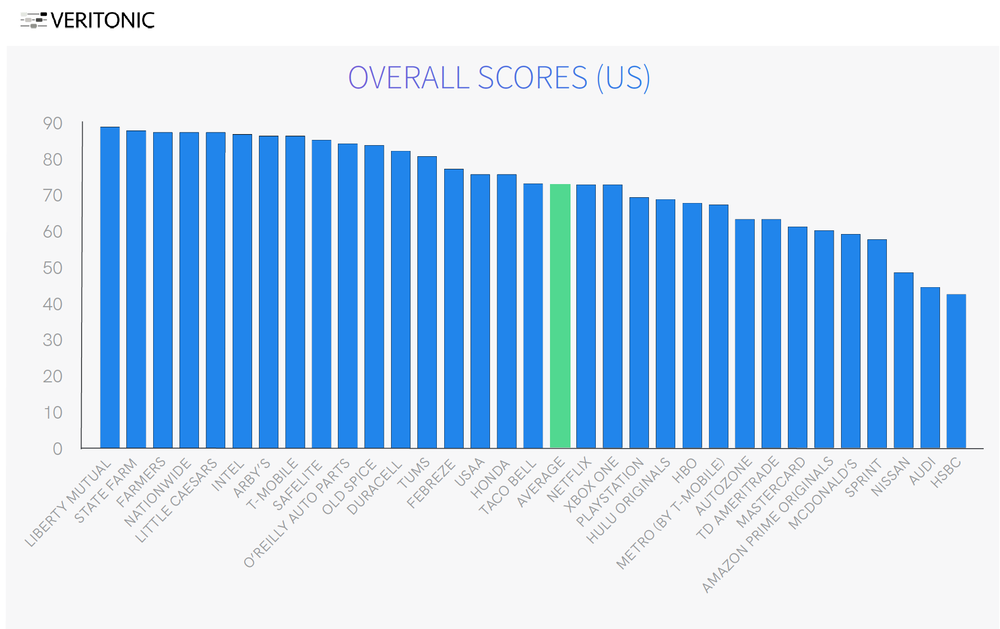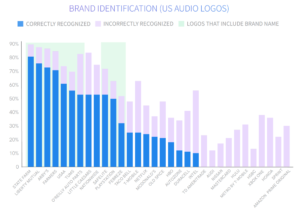
Steve Goldstein’s Amplifi Media works with media companies and podcasters in developing audio content strategies. Goldstein writes frequently at Blogstein, the Amplifi blog. Steve can be reached directly at 203-221-1400 or sjgoldstein-at-amplifimedia-dot-com.
There is so much of everything out there in medialand – so much video, so much web, so much audio. The challenge for content creators and advertisers is standing out amidst the supersized garden hose of content and choice.
In this moment when audio is seemingly exploding everywhere, how a brand sounds is on the radar in a way it never has been. In fact “sonic identity” – how a brand translates its essence into audio – is a relatively new question for many brands that until recently had written off audio and focused on video.
Sonic identity may be on trend, but it is not new. The famous NBC chimes date back to 1927 and was the first trademarked sound, as we wrote about here.
How brands create effective audio campaigns of course varies. Production style, copy, attractiveness of the product itself and the heft behind the marketing are all factors.

Veritonic Founder/CEO Scott Simonelli
I sat down with Scott Simonelli, Founder and CEO of Veritonic, an audio intelligence platform that measures the effectiveness of different kinds of sound. Most of their clients are advertisers looking to maximize the impact of an audio campaign, which includes ads, logos, jingles and identifiers. That’s no small task as brands look to develop more impactful relationships with customers.
For the fourth year they have published an Audio Logo Index ranking the most effective sonic brand ID’s. This year was bit different as part of the survey occurred during the early days of the pandemic.

Veritonic 2020 Logo Index
This is the fourth time you’ve done this project of ranking audio logos. What surprised you this time?
Authenticity is a big piece of the puzzle this time; it’s been important before, but you know, people are definitely in a climate now where authenticity is at a premium and people want to know that companies care. Everything around the virus counted and a good part of the survey was conducted in the midst of the pandemic. We carved out a special section this year to assess some of the brand ID changes that companies made to reflect the climate.
How are audio logos – little sounders — linked to the authenticity of a brand?
The audio logo is one immediate representation of the overall feeling a brand projects. Voices and certain sounds, in this case, if done right, build on that feeling of authenticity that a brand is creating at a higher level. It can be a critical part of brand association. The power of melody in particular creates a feeling right away. We track happiness, we track sadness, we track all these different emotions, but authenticity is one that is common in advertising, and obviously extra meaningful right now.
That’s interesting because in this year’s chart a lot of insurance companies, which I would not think of as authentic or warm, did extremely well. Why, do you think they popped?
A lot of it is about time and frequency in market, and a lot of it is about thoughtfulness. State Farm, Liberty Mutual, Farmers and Nationwide have been there a long time, with the exception of Geico, frankly, they all have a certain authenticity. Nationwide for example, has been going with the heartfelt for a long time. They are “on your side.” Liberty Mutual comes right in and just flat out says their name, they’re just kind of putting it out there. The Liberty Mutual logo is melodic. It says their name and uses human voice. Those are all things that can instantly create an authentic emotion. And again, this year, thoughtfulness in branding took on a new special meaning.
Liberty made a change in their audio signature, didn’t they?
Yes, great marketers are actively listening to their audience and adjusting to the climate. Liberty, for example, which jumped six places to number one in this year’s report, softened their logo for covid-related ads, essentially putting what makes that audio brand so memorable in the back seat. Liberty did a fantastic job of first investing in audio and continually putting a lot of thought into it, clearly making it a priority.
“One of the biggest and most consistent learnings of the Audio Logo Index is that putting the brand name in the logo drives much higher recall.”
State Farm had made a change previously. They had used a sound and now have integrated voice. Walk me through that.
 State Farm is a great example of both knowing your audience and paying attention to proven best practices. There is a certain saturation point, right? So if you just keep doing the same thing over and over again that might be effective for a while, but there’s eventually a tipping point where it becomes annoying or less impactful. So bringing words back into their sonic brand helped with that and also signifies listening to what the market responds to. One of the biggest and most consistent learnings of the Audio Logo Index is that putting the brand name in the logo drives much higher recall and proper brand identification. State Farm, as a result, jumped 14 points overall in this year’s index. Little modifications can go a long way.
State Farm is a great example of both knowing your audience and paying attention to proven best practices. There is a certain saturation point, right? So if you just keep doing the same thing over and over again that might be effective for a while, but there’s eventually a tipping point where it becomes annoying or less impactful. So bringing words back into their sonic brand helped with that and also signifies listening to what the market responds to. One of the biggest and most consistent learnings of the Audio Logo Index is that putting the brand name in the logo drives much higher recall and proper brand identification. State Farm, as a result, jumped 14 points overall in this year’s index. Little modifications can go a long way.
Conversely, Autozone again scored among the bottom 10 logos, likely because it again did not include its brand name in the sonic signature.
There has to be a relationship between the score in the Audio Index here and just tonnage. The ads for many of these are everywhere. What’s the correlation?
Everybody in any audio related industry knows the value of repetition. There is tremendous value in that. You hear something enough and you think you start to like it. If you’re going to spend that money you can drive recall and you can drive memorability. Intel is probably the best example of that. It’s hard to tell now whether that’s a great audio logo or it’s just been heard so much.
Is there a difference between an audio-only experience versus say Intel, which primarily runs at the end of TV commercials?
The audio of those ads is more and more important now as people use secondary devices like iPads and laptops while they watch TV. In other words, people can still be affected by hearing when they’re not watching – this is happening more than 60% of the time according to Nielsen.
“One of the things we talk about that kind of hides in plain sight is time. Time and audio are married.”
Not all sounders punch through. How about Honda’s logo at the start of their commercials?
It’s not a great audio logo. Maybe it’s a little too short. As far as automotive audio logos go, though, they are doing great; that sector however consistently performs poorly.
MasterCard is on the list, but I can’t even recall their sound.
They are an example of a good sonic strategy from an investment and comprehensiveness standpoint, but their mnemonic did not score well on the index. It may be due to the fact that there are SO many components to the sonic presence they’ve created that the simple single sound has suffered.
I thought this was interesting; you mention in the report that Little Caesars slowed down the voice that says “pizza pizza.”
Pacing is an interesting thing. One of the things we talk about that kind of hides in plain sight is time. Time and audio are married. That’s the first thing you learn when you were in composition school is how important time is. Often in sonic branding the audio logo piece is given a very short amount of time. But the pace at which somebody says a word can have a big impact on perception and recall. Words per second is important. I am definitely a Monday morning quarterback here, but it’s really hard to understand the name of the brand when they go so fast. And what the voice is even saying. Now you can tell.
“Podcast advertising is still in its early stages. The live read is like the early stages of television and the Texaco Theater live reads.”
Let’s talk about podcasts. Podcasts have prided themselves and done exceptionally well with live reads, almost the antithesis of everything we are discussing here. Thoughts on what will happen in the podcast space?
To not have a sonic strategy today, you’re probably not doing your job as a brand. Podcast advertising is still in its early stages. The live read is like the early stages of television and the Texaco Theater live reads which were great, but that doesn’t scale for a big brand. Eventually there are going to have to be other forms of advertising that occur within podcasts.
Let’s focus on that for a moment. Podcasting has grown up on Casper Mattress ads and part of the pitch has been about how every ad sounds the same everywhere else but within a podcast, the host is talking all about the product in a fresh way. There is a romantic component to that.
Endorsements align a brand with content as you know from your business. That’s a very powerful thing if done, right. Pepsi and music artists come to mind and countless examples of sports athletes. If it’s Joe Rogan or Bill Simmons or Howard Stern it can be a big differentiator. Tommy John who’s done work with us are big on that. But as audio scales there are going to have to be standards and expectations about how your brand sounds across all these different mediums whether that’s a live read or a five-second snippet of your audio logo, listeners must connect those dots.
“Nobody hums the copy”
Explain melody versus non-melody.
There’s a reason we sing the ABCs. One of my mentors in writing music, Carl Westman, said “nobody hums the copy.” Melody is memorable and recall is important. One thing that we’ve seen with every piece of data we have; melody is going to win at the end of the day. Find me a hit song that doesn’t have a great melody. On this year’s Logo Index, brands that leverage melody outperformed those that don’t with a nearly 15%-higher Veritonic Audio Score on average.
I’m thinking back to my radio programming days at WABC in New York. Way before I got there, in the 60’s and much of the 70s WABC had been the top radio station on the planet with 6 million listeners. Ask any New Yorker of a certain age today and they recall the WABC jingle and the chime. You knew which station you were listening to.
It works. And there’s no way we’re in our lifetime, that’s going to change.
Let’s talk about longevity. Duracell battery is one that’s been consistent and durable.
They have done it well and they have actually have a visual tie with the “copper top” thing going on. Mcdonald’s has done a fantastic job of that over the years investing in “I’m Loving It” and doing it different ways. And that’s when you have a good solid audio brand, a good solid sonic strategy, you can take those kinds of chances and see what happens and test it and kind of recalibrate.
How about Netflix, especially in this time of Covid-19.
Netflix has done a good job with blending, no rhythm. It is tonal. While it’s sort of “middle of the pack” overall, it always scores particularly well with a younger demographic.
We have talked about commercials, but there are sounds everywhere, my iPhone, my car …
Yes. Everywhere. We did something for Hilton where they were testing the audio logo their app makes when it opens your hotel room door. We have a partner called Audio UX, an agency that does functional sounds like the one my headphones make when they turn on. As the world becomes more voice centric and audio centric with smart speakers and connected devices and the more we talk to our cars, these sounds will be even more important.
Thanks Scott. Great data and observations.
Having a clear and compelling sonic identity is becoming more critical as brands and content creators look to differentiate themselves.
The full report is HERE and Veritonic has a great page chock full of audio logos HERE. The WABC jingle and chime is HERE
(This interview was edited for clarity. –SG)
